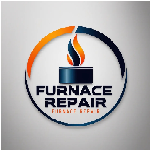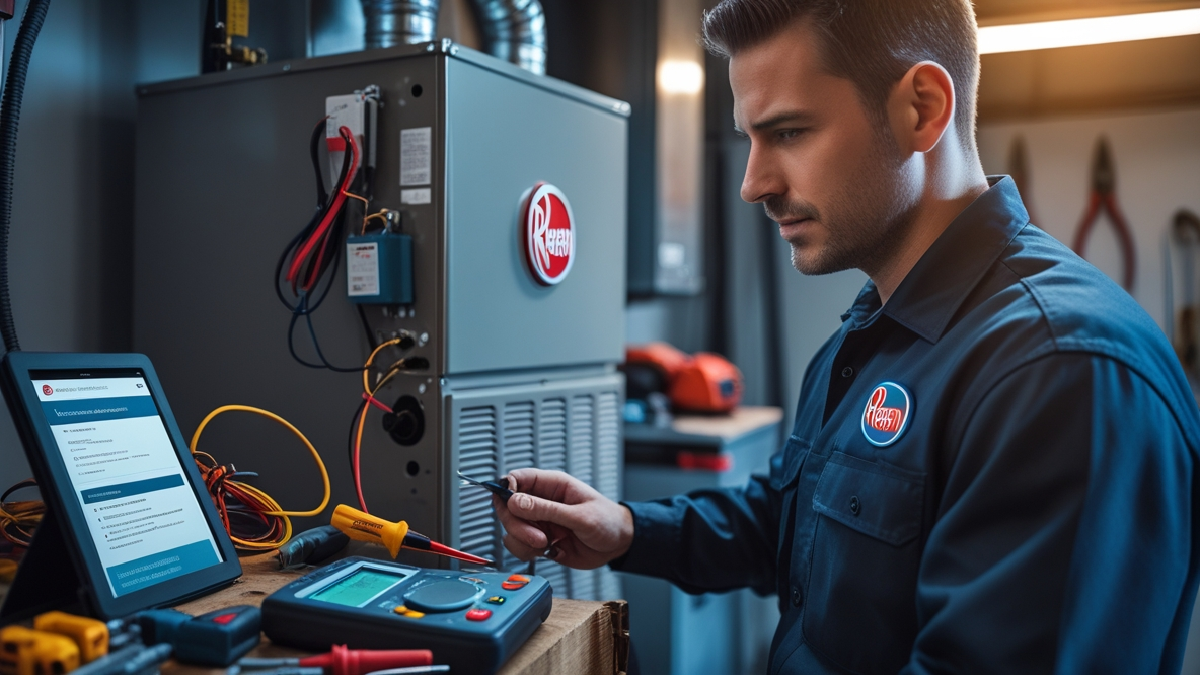Understanding Rheem Furnace Repair: A Homeowner’s Guide to Diagnosing Heating Issues
When your Rheem furnace isn’t functioning properly, it can be a source of frustration, especially during the cold months when reliable heating is essential for comfort and safety. Rheem Furnace RepairFortunately, many common heating problems are manageable by homeowners with a basic understanding of how the system works.

This guide aims to provide a comprehensive, step-by-step approach to Rheem furnace repair, focusing on simple troubleshooting techniques, safety precautions, and maintenance tips. Whether you’re a DIY enthusiast eager to learn or a homeowner seeking to understand your heating system better, this guide will help you identify issues early and determine when professional help is necessary.
Understanding Rheem Furnace Repair: The Basics of How Your Heating System Works
Before diving into troubleshooting, it’s crucial to understand the fundamental components and operation of your Rheem furnace. Rheem furnaces are known for their durability and efficiency, but like all mechanical systems, they can develop issues over time. The key components include the thermostat, blower motor, heat exchanger, igniter, and various safety switches. Recognizing how these parts work together will make diagnosing problems more straightforward.
The thermostat acts as the control center, sensing the temperature in your home and signaling the furnace to turn on or off accordingly. When the thermostat calls for heat, it sends a signal to ignite the burners or activate the electric heating elements. The heat exchanger then warms the air, which is circulated through your home by the blower motor. Safety switches and limit controls monitor the system for potential hazards like overheating, shutting down the furnace if necessary to prevent damage or danger.
Understanding this basic operation helps you identify where issues might occur. For example, if the thermostat isn’t working properly, the furnace may not turn on. If the blower motor fails, warm air won’t circulate. Recognizing these signs allows you to troubleshoot effectively.
Step 1: Prioritize Safety Before Starting Any Rheem Furnace Troubleshooting
Safety is paramount when working on any heating system. Before inspecting or handling any parts of your Rheem furnace, ensure the system is completely powered down. Start by switching off the power at the circuit breaker dedicated to your furnace. This step prevents electrical shocks and accidental activation during inspection.
If your furnace is gas-powered, turn off the gas supply to avoid leaks or potential explosions. Wear protective gloves and safety glasses if you need to handle burners or electrical components, as these parts can be hot or contain sharp edges. Never attempt to repair or inspect the furnace while it’s running or still energized, as this can lead to serious injury.
In case you smell gas or suspect a leak, evacuate the area immediately and contact your gas provider or a licensed technician. Remember, safety always comes first—if you’re unsure about any step, it’s best to consult a professional.
Step 2: Verify Thermostat Settings and Power Supply Rheem Furnace Repair
One of the simplest reasons a Rheem furnace may not be heating is incorrect thermostat settings or power issues. First, Rheem Furnace Repaircheck that your thermostat is set to “heat” mode and that the temperature setting is higher than the current room temperature. Sometimes, thermostats are accidentally switched to “cool” or turned off altogether.
Next, ensure the thermostat is receiving power. If it’s battery-operated, replace the batteries with fresh ones. For wired thermostats, check the circuit breaker to see if it has tripped. Rheem Furnace Repair Reset the breaker if necessary. Rheem Furnace Repair If the thermostat isn’t functioning properly, replacing it might be a quick fix to restore heating.
Sometimes, the problem lies with the wiring or the thermostat itself. If you notice the thermostat screen is blank or unresponsive, replacing or recalibrating it can often resolve the issue without further troubleshooting.
Step 3: Check the Furnace Power Switch and Circuit Breaker
Your Rheem furnace relies on a dedicated power switch, which is often located near the unit or on the wall. Confirm that this switch is turned on. Additionally, check your home’s main electrical panel to ensure the circuit breaker for the furnace hasn’t tripped. If it has, reset it by switching it off and then back on.
If the breaker trips repeatedly, this indicates an electrical problem such as a short circuit, faulty wiring, or an overloaded circuit. In such cases, avoid further attempts to reset the breaker and contact a qualified electrician or furnace technician to diagnose and fix the underlying electrical issue.
Step 4: Inspect and Replace the Air Filter
A dirty or clogged air filter is a common cause of furnace problems, including reduced efficiency and system shutdowns. Turn off the furnace before inspecting the filter. Remove it and examine it closely. If it’s covered in dust, dirt, or debris, it’s time to replace it with a new filter of the correct size.
Regular filter replacement is one of the simplest yet most effective ways to maintain your Rheem furnace’s health. Rheem Furnace Repair A clean filter ensures proper airflow, reduces strain on the blower motor, and helps your heating system operate efficiently. It’s advisable to check and replace filters every 1-3 months, especially during peak heating seasons.
If you notice persistent airflow issues or if the filter appears excessively dirty, consider upgrading to a higher-quality filter that offers better filtration and airflow resistance.
Step 5: Examine the Pilot Light or Electronic Ignition System
Depending on the model, your Rheem furnace may use a pilot light or an electronic ignition system. Problems here can prevent the furnace from producing heat. Rheem Furnace Repair For models with a pilot light, locate the pilot assembly and check if it’s lit. If it’s out, follow the manufacturer’s instructions to relight it safely.
For furnaces with electronic ignition, listen for the clicking sound when the system attempts to ignite. If you don’t hear this sound, or if the ignition fails to spark, the issue could be a faulty ignition module or sensor. In such cases, it’s best to contact a professional technician, as working with gas and electrical components can be hazardous.
Regular maintenance of the ignition system, including cleaning and inspection, can prevent many ignition-related issues and ensure reliable startup.
Step 6: Check the Blower Motor and Fan Operation
If your furnace turns on but doesn’t blow warm air, the problem might be with the blower motor or fan. Rheem Furnace Repair Observe whether the blower fan runs when the furnace is operating. If it’s not spinning, the motor could be faulty, or the fan belt may be broken or loose.
Listen for unusual noises such as squealing or grinding, which can indicate worn bearings or mechanical failure. Rheem Furnace Repair Cleaning the blower assembly and lubricating moving parts can sometimes restore proper operation. However, if the motor is burned out or damaged, replacing it may be necessary.
Proper airflow is critical for efficient heating, so addressing blower issues promptly can improve comfort and reduce energy costs.
Step 7: Inspect Safety Switches and Limit Controls
Modern Rheem furnaces have safety switches and limit controls designed to prevent overheating and other hazards. If these safety devices are triggered, they can shut down the furnace. Check for any error codes or indicator lights on your furnace’s control panel.
Resetting safety switches may involve turning off power, locating the switch or limit control, and resetting it according to the manufacturer’s instructions. Rheem Furnace Repair If these safety devices frequently trip, it indicates an underlying problem such as restricted airflow, dirty filters, or a malfunctioning blower.
Addressing the root cause of safety switch trips is essential to prevent future shutdowns and ensure your furnace operates safely.
Step 8: Use Diagnostic Codes and Error Indicators Rheem Furnace Repair
Many Rheem furnaces are equipped with diagnostic lights or error codes that can help identify specific issues. Refer to your furnace’s user manual to interpret these signals. For example, a flashing light pattern might indicate problems with ignition, airflow, or electrical components.
Understanding these codes can streamline your troubleshooting process and help you determine whether the problem is minor or requires professional intervention. If you’re unsure about what an error code means or how to resolve it, consulting a licensed technician is a wise step.
When to Seek Professional Rheem Furnace Repair
While many minor issues can be diagnosed and fixed by homeowners, some problems are best handled by professionals. If you encounter persistent electrical issues, gas leaks, heat exchanger problems, or if you’re uncomfortable working with gas or electrical systems, it’s crucial to contact a licensed technician.
Additionally, if your troubleshooting efforts do not resolve the heating problem or if safety switches keep tripping, professional diagnosis and repair are necessary to ensure your system’s safety and reliability.
Proactive Maintenance Tips to Keep Your Rheem Furnace Running Smoothly
Prevention is always better than repair. Rheem Furnace Repair Regular maintenance can extend the lifespan of your Rheem furnace and prevent many common issues. Schedule annual professional inspections to check the system’s overall health, clean burners, and inspect heat exchangers.
Homeowners should routinely replace filters, keep the area around the furnace clear of debris, and ensure vents and registers are unobstructed. These simple steps improve airflow, reduce energy costs, and help your furnace operate at peak efficiency.
Furthermore, consider scheduling professional tune-ups before the cold season begins to catch potential issues early and ensure your furnace is ready to keep your home warm.
Conclusion: Take Control of Your Rheem Furnace with Confidence
Learning how to diagnose and troubleshoot common Rheem furnace issues empowers homeowners to maintain a warm, safe, and efficient home environment. Rheem Furnace Repair By following these straightforward steps—checking power sources, inspecting filters, testing ignition and airflow, and interpreting error codes—you can often identify and resolve problems early, saving time and money.
Always prioritize safety, and don’t hesitate to call a professional when faced with complex or hazardous issues. Proper maintenance and timely repairs will ensure your Rheem furnace continues to provide reliable warmth for many winters to come.


Leave a Reply